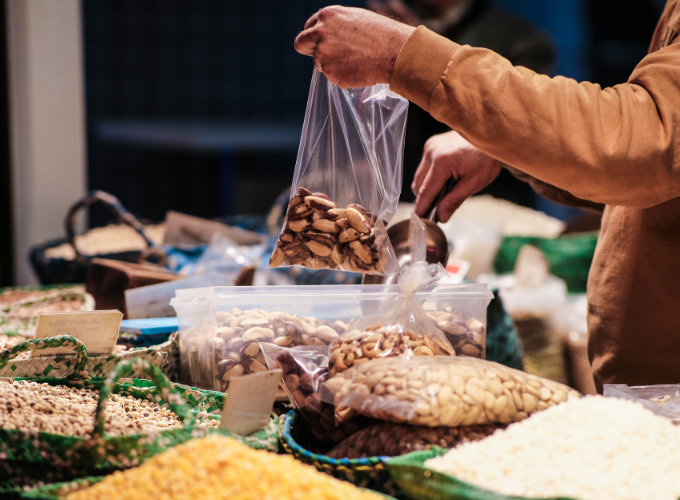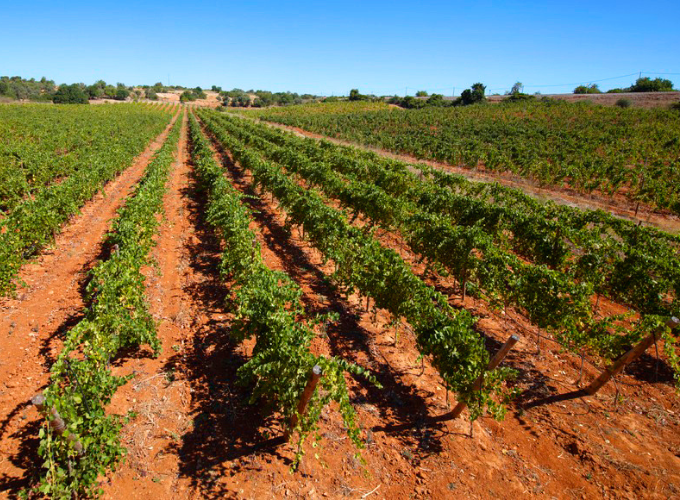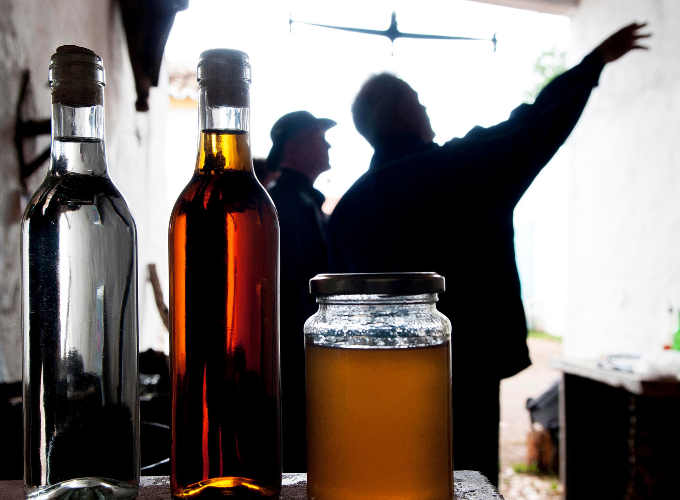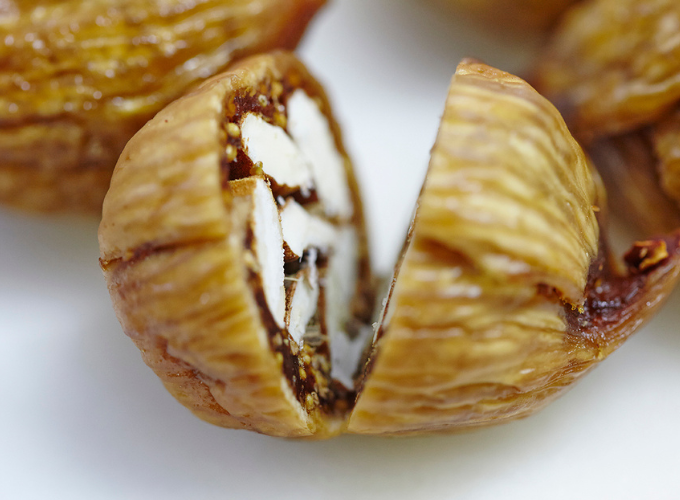ALGARVE, FRUITS OF THE SEASON
Now that most tourists have had their holidays and the Algarve is back to its usual routines, it's time to discover the region without the crowds. While the beaches are still inviting even in the low season, there is much more to visit. Take your time during your stay and hit the road. Each season has its own fruitfulness and charms.
In the summer, figs, plums, peaches, strawberries, watermelon, honeydew melon and cantaloupe fill the market stands with colour and are great additions for making meals fresher and lighter. The sweet, juicy Algarve oranges come off the trees practically all year round, although those classified as PGI (Protected Geographical Indication) with their thin peel, reach peak production between December and January, and in June and July. With the cold weather come persimmons, pomegranates, tangerines, pears and dried fruit, such as almonds, which are often eaten with dried figs. These are just some of the different flavours and colours that come from the same soil and demonstrate the riches to be found in the south of the country. The same goes for tourism; holidays are not solely reserved for the summer months in the Algarve, and it can be a nice surprise to get off the beaten track or walk the local footpaths.
NATURE
By bike from west to east
It may be a challenge to cover all 214 kilometres of the Algarve from Cape St. Vincent to Vila Real de Santo António, but there's no need to sweat it or try to win a gold medal; just pedal at your own pace and choose one section of the trail, and you’re sure to discover places you didn't even know existed. This is the beauty of the ecotrail which forms part of the European network of cycle routes as Route No.1 or the Atlantic Coast Route, between Sagres and Scandinavia. Kilometre after kilometre, there are cycle paths, rural roads and others running parallel to the busy National Road 125.
Another option, which also starts from Cape St. Vincent, is the Via Algarviana, which follows the interior of the region, through the Vicentine Coast Natural Park. From west to east, you will pass through fishing villages, beaches with cliffs and caves, the lagoon area of Ria de Alvor and the golf courses of Quinta do Lago, Ria Formosa, until you get to Vila Real de Santo António, the finishing line of this race. And if you're keen on two wheels, you can continue your journey north from here on the Grande Rota do Guadiana (GR15), as far as Alcoutim, over 65 kilometres which crosses the mountains from the coast to the Barrocal. And even if you're not speeding to try and win a place on the podium, whatever the route, you've won the best of prizes: the discovery of landscapes that are only within the reach of the adventurous. The routes are signposted, all you have to do is hire a bike and you can start pedalling; while paying due attention to the highway code. You can consult the entire cycling network at www.ciclovia.pt.

Birdwatching walk
Don't forget your mobile phone for the next walk – you're more likely to use the camera on your mobile than take a professional one – even if, by the end, you don't manage to capture any of the 300 species of birds that choose the Algarve as their destination. With autumn, many species arrive on their migratory routes or to nest, some very rare such as the Crested Coot or the Sanderling, others more common such as the Western Swamphen, the Squacco Heron, the Black-winged Stilt, the Egyptian Vulture and the Flamingo.
As a birdwatching destination par excellence, ornithologists, researchers and photographers arrive from all over the world to observe birds of prey, seabirds, waders (living in mud), ducks and perching birds, all of which can be found throughout the Algarve all year round, whether in coastal areas and marshes or in the mountains.
The region is part of the Natura 2000 Network - a Europe-wide network that aims to ensure biodiversity through the conservation or restoration of natural habitats to protect species - and is also classified as a Special Bird Area and IBA (Important Bird Area - Birdlife International). It won't be difficult to spot more than seagulls and you can add this activity to your bike ride. And it doesn't matter if you don't get a good photo; all you have to do is register with your eyes, observe what's around you, take in the colours of the horizon and feel the wind. Sometimes these are small things that make the moment memorable.
You can find information on the best observation points at www.avesdeportugal.info/algarve
CULTURE
Lagos Municipal Museum Dr. José Formosinho
A deep dive into the History of Lagos from the collection of José Formosinho (1888-1960), notary and archaeologist, who carried out several studies and excavations in the Algarve, at Portimão, Lagos, Aljezur, Vila do Bispo and Monchique. The finds were brought together to create the Lagos Museum in 1932, where vestiges of the civilisations that settled in the territory or fought over its lands can be found, from the Phoenicians to the Greeks, Carthaginians and Romans, up until the expulsion of the Moors.
After undergoing renovation work, the museum reopened with a new exhibition to complement the archaeology, numismatics, painting, regional ethnography and sacred art collections.
You can access the 18th century Church of Santo António from the museum. This religious monument impresses with the richness of its baroque gilded woodcarving and blue and white tiles, which make it one of the Algarve's artistic treasures and one of the most beautiful in the country.
Faro Story Spot
In the Largo da Sé in Faro’s Old Town, the 18th century house that was once the Pepa tavern, where shellfish gatherers and fishermen used to stop after their fishing trips to sell their catch, has been converted into a welcoming centre on the history of the city, its connection to the Ria Formosa and the Mediterranean diet. The multimedia centre is interactive and designed for the whole family, with a biologist and a sea horse acting as guides for visitors. There is plenty to learn about and, at the end, you won't just be left with your mouth watering, as there is also a tasting of traditional delicacies.
Instagram: @farostoryspot
CUISINE
Municipal markets
The main towns in the Algarve all have their own market. This is the best place to buy local food that forms the basis of the Mediterranean diet, classified as Intangible Cultural Heritage by UNESCO since 2013, offering fresh daily produce from the mountains and the sea. Fruits, vegetables, fish, seafood and dried fruit are all attractions. Some have other produce, such as bread, regional sweets and handicrafts.
In the Faro Municipal Market, in Largo Dr. Francisco Sá Carneiro, you can enjoy "Filó da Praça", a sweet pastry made by Filipa Carmo, which has become a symbol of the city. This young pastry chef, who has gained experience in Michelin-starred restaurants, created the pastry to mark the 15th anniversary of the market this year. Filó da Praça is made with 100% vegetable products: the filling is based on orange and almonds wrapped in a delicate crispy pastry.
The red brick walls of Olhão Municipal Market, overlooking the Ria Formosa, stand out in the landscape. A unique architectural feature, it dates back to 1916 when two markets were built, one for vegetables and the other for fish, which replaced the previous one dating from 1866. On Saturday mornings, the open-air outdoor market brings together the region's farmers and producers who sell their produce and add even more colour to the riverside area of Olhão.
In Quarteira, the fresh fish attracts attention on the stalls. Although the locals have long demanded new facilities, which the mayor has already announced, it's worth the visit, because the market retains the spirit of local commerce, with its stone benches and variety of local and seasonal produce. If you keep an ear out, you'll notice some of the everyday expressions used by the locals.

Vineyard visit
Algarve wine may not yet be everyone’s first choice, but like many of the region’s hidden corners, it is a secret that is slowly becoming known and the awards it has won, both at home and abroad, attest to its quality. There's nothing like going to the source and tasting the nectar to see for yourself.
Between Lagoa and Portimão, in the village of Estômbar, Quinta dos Vales reflects one man's passion for the country he moved to in 1996, for its wine and for the art of stone carving. This is the combination that makes the 44-hectare farm so special, with its vineyards and sculpture garden. The combination worked and the crops bore fruit, winning prizes among their peers at the most famous competitions. Since 2015, the business has brought father and son together and the two generations have given another boost to production, always with the same passion. Visitors are welcome, whether for solo tastings, workshops or a visit to the winery including a tasting with commentary. Enthusiasts can get involved in the production and even make their own wine, which is sure to keep you coming back to the Algarve. Book a visit, in whatever form best suits the time you want to spend there: tel. 282 431 036 / www.quintadosvales.pt
Quinta do Francês, on the way to the Serra de Monchique, provides a different experience. This nine-hectare family estate, built in traditional Algarve style, offers views over the Silves hills and vineyards and showcases wines that in their terroir reflect the region's warm, dry climate and the Atlantic sea breeze. Visits to the vineyard, cellar and winery take place in the morning and afternoon. They can be in English, Portuguese or French and include tapas to accompany the wine tasting - advance booking required. Tel. 282106 303 / www.quintadofrances.com

Taste medronho and traditional sweets
Medronho brandy is not for delicate palates, but it is an experience not to be missed; after all, as the saying goes "When in Rome, do as the Romans do", so when in the Algarve... Produced since the 10th century, originally by the Arabs in the Monchique area, this liqueur has maintained its traditional form of production, using copper stills, to this day, which has earned it the classification IGP - Protected Geographical Indication.
Climb up to the Miradouro dos Picos viewpoint to get a panorama over the village of Marmelete, where there is a guide to tell you about the whole process of medronho production. The Casa do Medronho, run by the local parish council, recreates a typical distillery and all the utensils used in the process. From there, you can get to know the distillers who preserve the tradition to this day. There are scheduled visits which can include other regional products, from sausages to sweets.
Tel. 282 955 121 / casadomedronho.com

HANDICRAFTS
There is always a souvenir to remember those times on holiday that you don't want to forget, but the best way to keep those memories safe and enhance the experience is to take a little of the Algarve's knowledge and traditions with you on your return.
There are many artisans who maintain the region's crafts and ancient traditions, so here are some suggestions as to where you can experience the production process first-hand: Palmas Douradas, visit the workshop of Maria João Gomes, in São Brás de Alportel (Instagram: @palmasdouradas), where you can get to know the art of palm weaving and all its products, from fashion accessories to decorative objects; Projecto Tasa, in Loulé, where handicrafts and design come together to enhance expertise and the materials, including canes, clay, tin, cork, wicker and linen cross the generations (projectotasa.com); in Castro Marim, the Local Market has been turned into a tourism and cultural centre to showcase local products and related crafts, where you will find anything from fleur de sel, honey, cakes, olive oil, preserves, liqueurs and basketry (www.castromarimlocalmarket.com).

RELAX
Spa
After exploring the region, on your return to the PortoBay Falésia, the Blu Spa is the perfect sanctuary to recharge your batteries. Indulge in a holistic journey into the marine DNA with an Oligomer® Spa massage, a Sea Salt Scrub or an Oxygen Anti-ageing, a regenerating facial ritual that takes advantage of the nourishing properties of fruits such as orange, tangerine, grapefruit and grape, to continue the local experiences and get the Algarve literally under your skin.
